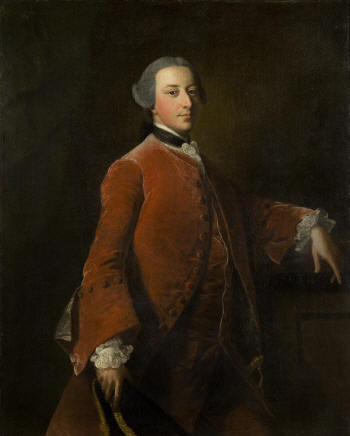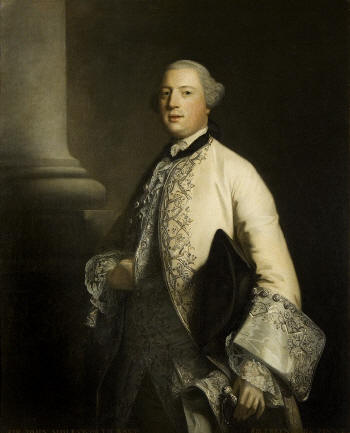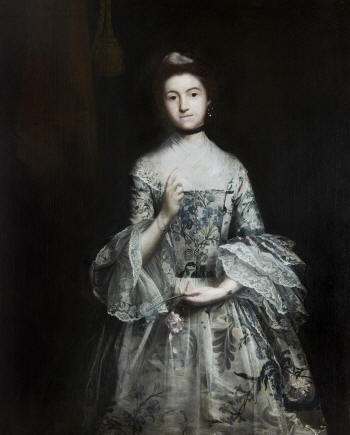|
|
| home | features | exhibitions | interviews | profiles | webprojects | gazetteer | links | archive | forum |
|
Sir Joshua Reynolds: The Acquisition of Genius Essay written by Sam Smiles to coincide with Sir Joshua Reynolds: The Acquisition of Genius at Plymouth City Museum and Art Gallery
The purport of this discourse, and, indeed, of most of my other discourses, is, to caution you against that false opinion, but too prevalent among artists, of the imaginary power of native genius, and its sufficiency in great works. That opinion, according to the temper of mind it meets with, almost always produces, either a vain confidence, or a sluggish despair, both equally fatal to all proficiency. Throughout the fifteen Discourses he delivered at the Royal Academy Reynolds frequently returned to the idea that an artist’s creative potential cannot be fulfilled unless it is channelled effectively; genius can flourish properly only when the artist’s craft is thoroughly understood. However, Reynolds’ understanding of the artist’s craft embraced much more than technical excellence: the professional artist should also be able to draw on the resources of a well-stocked mind. For Reynolds, it was ‘indisputably evident that a great part of every man’s life must be employed in collecting materials for the exercise of genius.’ If the artist was not to exhaust his imaginative capabilities the mind’s intellectual and creative resources needed to be enhanced, primarily by studying the old masters and observing natural appearances. And he emphatically rebutted those who claimed that such knowledge would inhibit their creativity: ‘... there is no danger of the mind’s being over-burthened with knowledge, or the genius extinguished by any addition of images; on the contrary, these acquisitions may as well, perhaps better, be compared ... to the supply of living embers which will contribute to strengthen the spark, that without the association of more fuel would have died away.’ Genius must therefore be directed and cultivated if it is to animate the arts and it is the responsible artist’s duty to work towards that goal. This is why Reynolds claimed that genius on its own was not enough, leading only to ‘vain confidence’ if it was not combined with proper study and hard work. As he noted in 1769, ‘excellence is never granted to man, but as the reward of labour’ and his own career can be examined with this in mind.
Reynolds returned to England from Italy in 1752. The following year he established himself in London and over the next decade, in his thirties, he built the reputation that sustained his career. He maintained his connections with important West Country patrons and developed an extensive portrait practice among the social elite of England, he was friends with many of the most creative personalities of the day and he was a figure to be reckoned with among his fellow artists. This professional prominence saw him elected President of the newly established Royal Academy in 1768. On the evidence of his pronouncements in the Discourses, Reynolds would have understood his pre-eminence in the London art world as the reward not merely of his creative talent, but of his diligence and application in his profession. He was knighted in 1769, the University of Oxford conferred on him the title of Doctor of Civil Law in 1773, the same year he was made Mayor of Plympton, and in 1784 he was appointed Painter in Ordinary to King George III. As President of the Royal Academy, Reynolds was in a good position to argue for the intellectual and cultural worth of the fine arts. The Discourses, although ostensibly addressed to the students of the Royal Academy, were designed to make a contribution to contemporary discussions on aesthetics, the history of art and the cultivation of taste. Reynolds’ characterisation of the artist as a professional, combining intellectual understanding with facility of hand, his insistence that genius can be taught, may be understood as necessary strategies within a wider campaign to raise the standing of the artist in Georgian England. Throughout his Discourses he is at pains to present painting as a liberal profession, combining intellectual powers with creative imagination, and thus quite distinct from what its detractors would call merely a mechanical trade, reliant solely on technical skills and the servile imitation of reality. In essence, what Reynolds proposes is that artists have the ability to conceive a subject imaginatively and can convey its essential quality or significance by employing a generalised treatment of visual appearance, beyond any concern with minute details. This ability is ‘an instance of that superiority with which mind predominates over matter, by contracting into one whole what nature has made multifarious.’
As part of this assertion of the dignity of his profession, and notwithstanding the fact that he enjoyed a good living from his portrait practice, Reynolds drew a sharp distinction between cultural value and economic value. His pupil James Northcote transcribed one of Reynolds’ notes recording his rebuttal of a remark made by the economic theorist Josiah Tucker, the Dean of Gloucester, that ‘a pin-maker was a more useful member of society than Raffaelle.’ Reynolds vigorously opposed such thinking, pointing out that the arts and sciences contributed to civilization by providing ‘the rational enjoyment of life... opening scenes of intellectual pleasure and instruction by means of the senses.’ The arts and sciences would thus improve society, which Reynolds understood as a community of rational beings bound together in a common purpose. By comparison, Tucker’s high estimation of commerce was, for Reynolds, the product of ‘a very narrow mind’ which elevated mercantile self-interest over the commonweal. As he noted in his ninth Discourse, delivered in 1780: 'The estimation in which we stand in respect to our neighbours, will be in proportion to the degree in which we excel or are inferior to them in the acquisition of intellectual excellence, of which Trade and its consequential riches must be acknowledged to give the means; but a people whose whole attention is absorbed in those means, and who forget the end, can aspire but little above the rank of a barbarous nation'. The intellectual excellence that Reynolds recommends is something to which artists can contribute and one of the principal aims of the Discourses is to show how this can be achieved. Assessing the value of artistic creativity
in contemporary society is, of course, not just an eighteenth-century
concern. The terms of the debate change, and the structure and funding
of today’s art world are very different from anything Reynolds can have
imagined, but the fundamental issue remains the same: what is the
purpose of creative and intellectual activity and how can its
contribution to society be fostered? The temptation is always to
subordinate creative work to the pressing needs of trade and industry.
Reynolds, however, was adamant that economic priorities alone cannot
sustain a healthy society. Genius, whether innate or acquired, makes a
contribution beyond the reach of a commercial reckoning.
‘Sir Joshua Reynolds: The Acquisition of Genius’ will be between 21 November 2009 to 20 February 2010 Reynolds was born in Plympton in 1723 and went on to become one of Britain's finest and most fashionable portrait painters. He was knighted in 1769 and was also a founder and the first ever President of the Royal Academy of Art. Though he found success in London Reynolds never forgot his roots and many of his closest friends and clients were from the South West. This previously under-researched aspect of Reynolds’ career will be highlighted in the exhibition with a section specifically dedicated to his local links. Amongst other works of art, this section will include loan items from the Royal Cornwall Museum, Truro; Pencarrow House, Wadebridge and National Trust property Antony House, Torpoint. Works belonging to the Museum which are usually on show at Port Eliot, St Germans will also feature.
images top to bottom |
|
|



